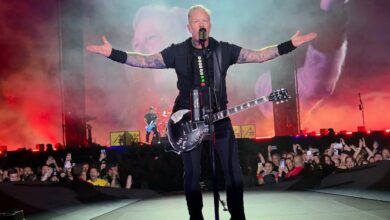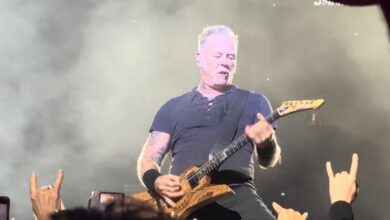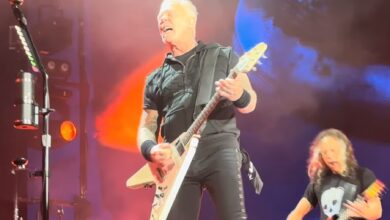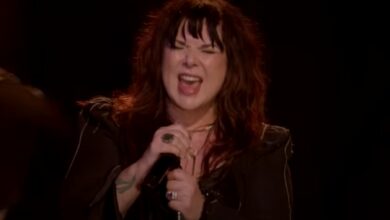Bruce Dickinson Stuns NFL Crowd With National Anthem at Steelers-Seahawks Game, Igniting Calls for Iron Maiden Super Bowl Halftime Show
On Sunday, September 14, 2025, Pittsburgh’s Acrisure Stadium delivered one of those “did that really just happen?” pre-kickoff moments that sports and music fans live for. As the Steelers prepared to host the Seattle Seahawks, Iron Maiden frontman Bruce Dickinson strode to midfield and took the mic for “The Star-Spangled Banner.” The pairing sounded improbable on paper, but in the stadium it made instant sense: a powerhouse vocalist with arena-honed projection, tens of thousands of football fans hungry for opening-day theater, and a game with enough stakes to make every second count. By the final note, the only question echoing around social feeds was whether the NFL might dare to go all-in and book Maiden for a Super Bowl set.
Part of the magic was the surprise factor. News of the anthem wasn’t teased through a weeks-long campaign; it landed like a jolt in the game-day bloodstream. Music press and NFL photowires confirmed the moment, pinning it squarely to Steelers-Seahawks at Acrisure, with crisp sidelines images of Dickinson facing a sea of Terrible Towels under a late-summer sky. The specificity mattered: this wasn’t a pulled-from-archive clip or a rumor mill fever dream. It happened, here, now—an English metal icon honoring an American tradition in front of a capacity NFL crowd, creating the kind of cultural crossover that algorithms can’t manufacture.
If you watched the performance videos, you could feel two decades of stadium experience snapping into place the second he drew breath. Dickinson kept the melody clean and the pacing tight—no gratuitous melisma, no showboating detours—yet he still brought a singer’s sense of drama to the harmonic peaks. He shaped phrases like a front-of-house pro who knows how sound behaves in a bowl, punching consonants so the upper deck could ride the lyric while letting long vowels bloom across the field. The result balanced reverence and roar: unmistakably the anthem, unmistakably Bruce, and unambiguously big enough for football’s largest regular-season stage.
What viewers didn’t see in the broadcast angle is how much intent preceded that composure. A few nights earlier in Boston, during a solo tour stop, Dickinson let the cat out of the bag from the stage—half-confession, half-wink—about the NFL invite, and he even ran the anthem in a casual setting to feel it in the body. That tiny breadcrumb did two things: it showed he respected the assignment enough to prep, and it cued fans to listen for fidelity over flash. The Boston preview wasn’t a stunt; it was a musician calibrating dynamics before stepping into a different arena with different stakes.
On the day, the stadium optics were textbook NFL pageantry: a field-sized flag, camera cranes sweeping the sidelines, players helmet-off and focused, and a crowd that shifted from chatter to attention as the first notes rang out. If you were on the concourse grabbing one last bite, you hurried to a portal; if you were in your seat, you stood a little taller. The anthem marks the hinge between spectacle and sport, and on this afternoon it was more than ritual—it was ignition. That’s by design in pro football, but the vocalist matters. An anthem that connects doesn’t just precede the game; it primes it.
The fan response was immediate and global, the way only modern NFL moments can be. Rock outlets posted fast recaps, metal sites clipped audience angles, and social media filled with thumbs-stopped-mid-scroll reactions. “I didn’t know I needed this” and “most random thing I saw today” were common refrains, but so were comments from longtime Maiden listeners who recognized the control and restraint beneath the bravado. Tight vibrato at altitude; a centered pitch on the “free”—the little technical wins that tell you someone took the job seriously even while having fun with the scale of it all.
Crucially, the moment wasn’t just captured by fans’ phones. Bruce acknowledged it himself with a gracious thank-you that underscored how unusual—and how cool—the booking was. In an era when celebrity moments can feel contractual, his note felt earned: appreciation for the NFL platform, a nod to Steelers Nation, and an implicit salute to the anthem tradition he’d just stepped into. That one post effectively tied a bow on the day, validating what people saw and giving it a tidy, sharable endpoint from the man at center field.
For the NFL, the booking was a savvy bridge between demographics. Pittsburgh is a legacy football town; Iron Maiden is a legacy stadium band. Both are intergenerational machines fueled by ritual, merch, and memories. Putting a metal icon in front of a 66,000-strong NFL crowd didn’t just goose the pre-game—it reinforced the league’s knack for pop-cultural crossovers that feel both unexpected and, afterward, inevitable. It’s not hard to imagine schedulers clocking the social metrics in real time and filing away a mental note: hard rock and helmets play well together in 2025.
There’s also the simple physics of voice. Metal vocalists who last learn breath management, vowel tuning, and dynamic discipline—skills tailor-made for a challenging, anthem-length sing in open air. You could hear that discipline in how he paced the early verses, saving gas for the crest and making the climactic octave land cleanly without drifting sharp. No in-ear mix theatrics, no hidden choir crutches—just a frontman and a field, riding the natural reverb of the bowl and trusting lungs, larynx, and long practice to carry the flag.
For Steelers fans, the memory slots neatly among the city’s sports-music lore: just different enough to feel distinctive, just classic enough to feel at home. Pittsburgh doesn’t mind a little grit on its glamour—a steel-city brand that dovetails with Maiden’s work-ethic storytelling. And if you think that’s stretching the metaphor, check the crowd shot when the camera cuts to the 500 level: jerseys next to vintage band tees, families next to friend groups, all locked into the same ritual. The anthem levels the room; the right singer lifts it.
What made this instance special wasn’t a novelty “metal singer does anthem” pitch. It was the way the performance threaded the needle between ceremony and personality. Too stiff, and it becomes background noise; too self-indulgent, and the internet torches it by halftime. Dickinson threaded it. He honored the tune, colored within the lines, and still left his initials on the canvas. The last note didn’t beg for applause; it earned it, and then it yielded the stage to football like a pro handing off the baton.
The ripple effect outside the stadium was measurable. Music trades covered it as culture news, NFL feeds clipped it for international fans, and terrestrial radio sites amplified local angles (“Maiden’s singer at our stadium!”). That relay—from press to social to broadcast—turned a two-minute performance into a multi-day story that reached people who don’t normally watch pre-game. It’s the kind of cross-pollination leagues chase and bands welcome: everybody’s audience gets a little bigger, and the Venn diagram’s overlap becomes a new community for a few days.
Then came the inevitable ask: if Bruce can light up a stadium before kickoff, what might a full Iron Maiden production do under the Halftime lights? It’s one thing to nail the anthem; it’s another to scale pyro, props, and Eddie-sized theatrics for 12 minutes of TV built for pop. But the buzz wasn’t about certainties; it was about possibilities. The anthem proved there’s audience appetite for heavy music on football’s biggest stages. Whether the league charts that course is an open question, but the seed is planted—and it sprouted in Pittsburgh.
From a storytelling standpoint, the moment also spotlighted how live performance still cuts through the noise. In a week of endless clips, this one stuck because the stakes were clear and the frame was clean: a single voice, a single song, a shared ritual. You don’t need to be a Maiden devotee or even a music diehard to feel that. The anthem belongs to everyone in the building for those two minutes, and when the delivery is confident and sincere, it resets the emotional thermostat for the game to follow.
And if you’re keeping receipts, the documentation is plentiful. You can watch the broadcast-style angles that capture the stadium sound and see the crowd rise at the “free.” You can jump to fan-shot video from the lower bowl for closer-in acoustics and hear how the timbre holds together without studio polish. You can scroll Bruce’s own thank-you to feel the human handshake at the end of a big day. Each artifact tells the same story from a different vantage: this happened, it was good, and it mattered.
In the long history of national anthems at sporting events, not every performance gets remembered past the final whistle. This one will, because it carried narrative weight on multiple levels—genre surprise, technical execution, city identity, and the ongoing conversation about who gets to command America’s largest communal stages. On September 14 in Pittsburgh, a British metal singer stood in the center of an NFL field and delivered a faithful, full-throated “Star-Spangled Banner.” The crowd stood taller, the cameras drank it in, and a game kicked off with a story fans will retell long after they’ve forgotten the box score. That’s the mark of a moment that stuck.
Finally, consider the broader legacy play. Iron Maiden has packed stadiums for decades with narratives that eclipse genre labels—songs about endurance, conflict, and myth scaled for mass catharsis. Football, at its theatrical best, does the same with different tools. For a brief pre-game interlude in September 2025, those two languages spoke as one. And if you felt, even fleetingly, that Maiden at the Super Bowl no longer sounds like a long shot but like a thrillingly plausible idea, well—Pittsburgh just handed the league a very loud, very melodic piece of evidence.





